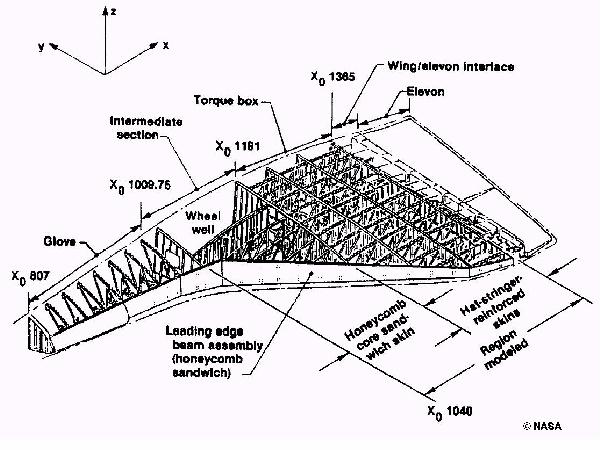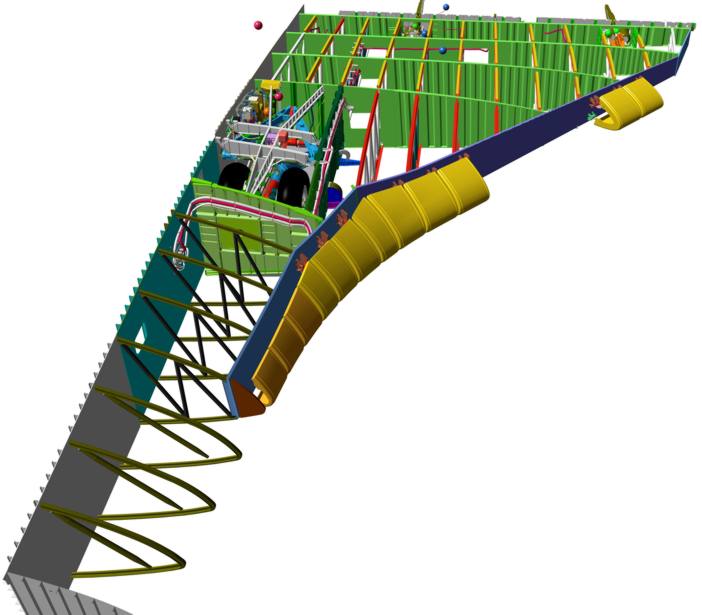
| The annotated
timeline below assumes that the damage to Shuttle Columbia was caused by
an icy stalactite from the External Tank shattering an inboard (#6 or
#7) RCC left wing leading-edge section on launch. It further assumes
that the object seen by radar to detach in orbit (after a mild manoeuvre)
and float in the Shuttle's vicinity was a large segment of that
shattered RCC section (having become dislodged after a number of
"towards and away from sun" in-orbit heat-cycle exposures). Based upon
the fact that the RCC section's anti-oxidizer coating would have been
compromised by the shattering, it is theorized that re-entry heating
would have quickly caused the remaining segments of that shattered RCC
section to dislodge and create a superheated (S/H) plasma spike ahead of
that section (due to the oblique flat-plate of the now uncovered
aluminium wing leading-edge flying at a very high Mach No). In seq 24.8
below, the increase in temperature rise-rate of the supply water nozzle
(21ft ahead of the RCC sections) is explained by the flat-plate
effect generating the "projected ahead" super-heated plasma
spike - and that plasma spike being initially deflected inwards towards
the nose of the Orbiter by the (then) intact RCC section just outboard
of the initially shattered section.
The progressive "unzippering" of
further outboard RCC sections would have eventually led to a loss of
lateral control (and a change in shape and ahead projection of the S/H
plasma spike). Contributing to this would have been the breach burnt
between the flat aluminium wing leading-edge and the wheel-well (just
behind it). It has been established that the wheel-well was "eaten out"
from the inside and a through pathway (an exit) latterly established for
itself by the superheated plasma. The New Mexico USAF Starfire photo (seq
49.55) later captured the ahead-projected super-heated plasma spike on
film. It is possible (seq 71/72) that the left wheel-well door opened,
contributing to the unmanageable asymmetric drag rise and causing the
loss of control seconds later.
The evidence for this process
starts at seq 24.8 (time 1352:52) below (and is explained further
in
this link). Some supporting links are shown at the bottom of
this timeline. |
|
| Seq |
Time |
Event |
Observation/Deduction |
| 14 |
1344:09 |
Entry Interface |
|
| 20 |
1349:32 |
Initial Roll |
starts exposing LE to varying angles of
attack (which may start dislodging
residual shattered RCC section, particularly as section heats up
(anti-oxidization seal no longer intact)) |
| 20.5 |
1350.30 |
first re-entry heating |
|
| 21 |
1350:53 |
start of peak heating |
|
| 21.5 |
1351:19 |
earliest off-nominal events (continue for 90
secs) |
roll & yaw thruster firings
(so
surface damage requiring compensation must have existed already) |
| 24 |
1352:17 |
left gear brake-line D starts heating up |
located wheel-well inbd sidewall (possibly
indicates that superheated plasma is heat-transferring by conduction even if
wheel-well is not yet penetrated via L.E. breach). |
| 24.3 |
1352:25 |
off-nominal comms dropouts |
first experienced at 1350.00. Upper Left
antenna
(S-Band signal shielded by
superheated plasma projection ahead of left wing). Subsequent drop-outs
likely also caused by plasma and changing aspect to receiver station.
|
| 24.8 |
1352:52 |
Supply H2O dump Nozzle temps A/B show
temporary increase in temp rise- rate (15 second duration of high rise
rate). 24 secs later returns normal |
Unfortunately no indication
of any assoc normal re-entry roll manoeuvring that may have increased AoA
and projected S/H plasma bubble further ahead of leading edge
(Supply H2O dump
nozzle is about 21feet ahead of the RCC tiled leading edge). |
| 26 |
1352:41 |
left gear brake-lines A&C begin off nominal
temp-rise |
further conduction of S/H
plasma heat into the (as yet) unbreached wheel-well (due to heat having
reached aluminium wing structure at the L.E.) |
| 26.6 |
1352:47 |
Supply H2O dump Nozzle temps A/B return to
normal rise-rate |
S/H plasma bubble
[due to flat plate effect of single missing RCC section] now no longer
projecting as far ahead of leading edge -nor being deflected inboard toward
Orbiter nose by next RCC section along -
due to progressive lateral erosion
of that [next along] RCC section (and its eventual disappearance),
plus gradually reducing Mach No generating slightly smaller shocks. Timing
of Vacuum vent (further aft than dump nozzle) reflects rate of S/H plasma
bubble's retreat back towards leading edge. In addition events from this
point forward would indicate that LE breach has reached the wheel-well (a
further cause for S/H plasma bubble no longer being projected as far forward
and inboard). |
| 26.65 |
1352.55 |
Vacuum vent temp returns to typical rise
rate. |
| 26.7 |
1352:56-59 |
Left INBD Elevon Lower Skin Temp - OSL |
Because aileron is
down-deflected to counter L rolling tendency it is receiving aerodynamic
cooling (that counters the surface heating) |
| 29.5 |
1353:26 |
coast crossing |
any
initial RCC section fragment separation overwater may not have been noted by
ships at sea. |
| 30.3 |
1353:54 |
indications of off-nominal heat-rise in lower
mid-fuselage areas |
abnormal S/H plasma heating has transferred
by conduction along wing structure and structural members and reaches the
fuselage. |
| 32.1 |
1353:44 -50 |
visual debris in night sky |
Simultaneous events. Probability
of wing LE to wheel-well plasma channel established at this point
(as RCC sections continue to erode away outboard) |
| 32.5 |
1353:46 |
Left gear brake line temp A starts rapid
heat-rise |
| 32.7 |
1353:54-58 |
Momentary brightening of plasma trail |
possibly caused by a new material being
incendiarized as S/H plasma reached the wheel-well. It may also have been
the moment that a wheel-well plasma exit hole was established (entry/exit of
plasma into wheel-well likely to have been near coincidental). However,
unlikely due next event (seq 33) and event at 1354:33 (seq 36.5) |
| 33 |
1354:10 |
LMG brake-line temp B abnormal temp-rise |
caused not by conduction (or direct flow
impingement) but by convection of plasma circulating within wheel-well (over
the preceding 24 secs). |
| 34 |
1354:20 |
start of slow aileron trim change |
force-trim (holding LIE/LOE down) changes due
to increasing drag of gradually "eating away" (towards outboard) of LE RCC
sections and plasma bubble shape-change |
| 35 |
1354:22 |
rapid increase in temp rise-rate along
mid-fuselage bond-line (& aft fuse BL) |
rapid heat-rise within the now-penetrated
wheel well is being conducted along structural members to the mid-fuselage
(and very shortly thereafter to the aft Left fuselage sidewall) |
| 36.5 |
1354:33.3 to
1354:33.9 |
Flash #1 - Orbiter envelope suddenly
brightened (duration 0.3 sec), leaving noticeably
luminescent signature in plasma trail (Debris #6 -very bright) |
Although RCS jets fired at
this time also, their intervention was possibly due to the wheelwell S/H
plasma exit hole becoming established (initial pinhole widening).
Nature of exiting plasma changed by
journey through wheel-well |
| 36.6 |
1354:35-37 |
Debris #6 - Very bright debris seen leaving
the Orbiter |
incendiarized debris from
wheel-well exiting the widened exit-hole |
| 40.1 |
1355:21-27 |
Debris #8 - Eighth report of debris observed
leaving the Orbiter. Event was followed by momentary brightening of plasma
trail. |
Debris event #'s reached #15 by 1356:13.
Likely attributable to further RCC sections being lost plus some under-wing
tiles. |
| 42.8 |
1355:58 |
Debris $14 |
Debris #6 and #14 were the
two brightest events |
| 49.55 |
1357:19-29 |
Starfire Photo over New Mexico |
shows
S/H plasma bubble prominently projecting forward of inboard left wing and a
stream of particles aft of inboard wing section. |
| 49.6 |
1357:19-24 |
L MLG tyres show pressure changes |
increases due to wheel-well heat throughflow? |
| 54 |
1358:03 |
Start of "sharp" aileron trim increase |
preceded at 1358:00:48/01:44 by a 0.96sec RCS
pulse firing (i.e.
then computer
decided that asymm situation was permanent and required a trim-change) |
| 55.5 |
1358:20 |
crossing New Mexico/Texas border
209,800ft and Mach 19.5 |
|
| 57/58 |
1358:32 |
both tyre pressures trending down |
simultaneously pierced(?) or
thermal fuses have operated (more likely) |
| 58.5 |
1358:32 |
wheel temp trending down towards OSL |
sensors are being knocked out
by high wheel-well temps |
| 60/64 |
1358:38-40 |
both L tyres' pressures OSL |
tyres' thermal fuses have operated (seqs
57/58) |
| 70 |
1359:06 |
Left gear downlock indication |
microswitch (or wiring) cooked by high
temperatures (gear uplock still indicating) |
| |
1359:07 |
aileron trim reached max allowable by FCS |
as a result of RCC section loss and
resulting wing tile losses |
| 71/72 |
1359:30 |
Both R2R and R3R RCS jets firing |
long pulses (each) of 5 secs at least
(indicating massive rise in drag asymmetry) -
suggest wheel-well door had opened-
initiating LOC (loss of control) |
| 73 |
1359:31 |
significant elevon deflections |
Left: -8.11 deg (up); Right: -1.15 deg (up)
(together with RCS firings insufficient to compensate
wheel-well door opening) |
| |
1359:32 |
loss of signal |
LOS attributable to rapidly changing Orbiter
flight attitudes. BREAKUP delayed until loss of control had been in effect
for period of approx 50 secs. Some indications that flight control system's
force-fighting in that period was due to interdiction of wiring by
wheel-well events plus voltage drops caused by massive shorting.. |
| 100 |
1400:02-06 |
large debris seen falling from Orbiter |
Pre-Break-up LOC apparently initiated by
wheel-well door opening (and not left wing burn-though) |
| 110 |
1400:21-25 |
Main Vehicle Body Orbiter Breakup |
|




